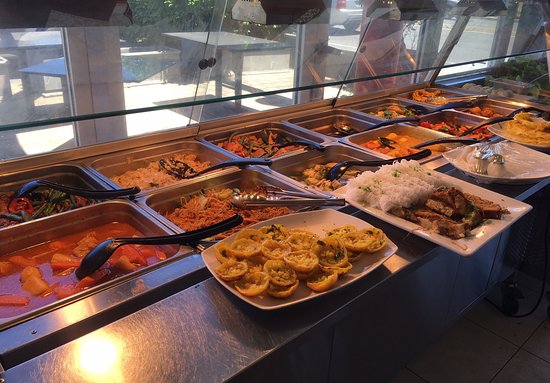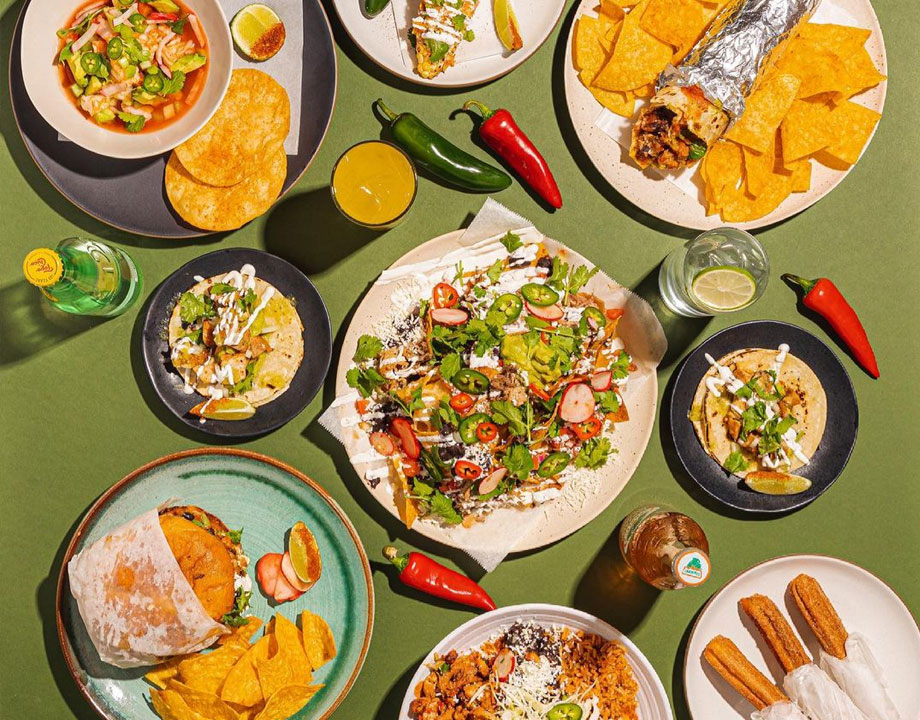Eating Delights: Explore Innovative Restaurants Transforming the Food Scene
The modern dining landscape is experiencing an amazing transformation, marked by innovative dining establishments that are redefining cooking norms. From the increase of pop-up facilities embracing seasonal components to immersive experiences that engage the detects in extraordinary means, these locations are establishing new requirements of what it suggests to enjoy a meal. In addition, an expanding focus on sustainability and regional sourcing mirrors a dedication to both high quality and neighborhood. As we explore these patterns, the question emerges: what future advancements might additionally reshape our cooking experiences?
The Rise of Pop-Up Restaurants
As the culinary landscape develops, pop-up restaurants have become a dynamic pressure, enchanting food enthusiasts and business owners alike. These momentary eating establishments, usually established in unusual spaces, supply a distinct blend of imagination and accessibility, interesting a varied variety of consumers. The surge of pop-up restaurants can be attributed to several elements, consisting of the expanding need for novel eating experiences and the entrepreneurial spirit of cooks keen to check their culinary concepts without the financial burden of a permanent location.Pop-up restaurants enable cooks to try out food selections, designs, and styles, often concentrating on seasonal or locally-sourced active ingredients. This flexibility not only promotes technology but likewise creates a sense of seriousness, as customers are drawn to the limited-time offerings. The ephemeral nature of pop-ups grows a buzz around the eating experience, urging social networks sharing and word-of-mouth promo, which can greatly improve presence and draw in a loyal following.Furthermore, pop-up restaurants commonly deal with particular niche markets, varying from vegan and gluten-free alternatives to ethnic cuisines, thereby satisfying the diverse dietary preferences of modern consumers. Consequently, these establishments contribute to the abundant tapestry of the food scene, pushing borders and difficult standard notions of eating.
Immersive Dining Experiences

Sustainable Practices in Food
Accepting sustainability, innovative dining establishments are redefining their cooking practices to reduce environmental effect while enhancing the dining experience. These facilities prioritize local sourcing, typically collaborating with nearby farmers and producers to assure that components are fresh and seasonal. This not just minimizes the carbon footprint connected with long-distance transport however additionally supports local economies.In addition to sourcing, dining establishments are progressively taking on techniques that reduce waste. Numerous are implementing composting systems and using food scraps artistically, changing what would commonly be discarded into delicious parts of brand-new meals. For instance, vegetable trimmings can find brand-new life in stocks or garnishes, while stale bread is repurposed into croutons or bread puddings.Moreover, the trend towards plant-based menus is acquiring momentum (Restaurants). By highlighting vegetables, grains, and vegetables, dining establishments can considerably lower their environmental impact, as plant-based foods usually need fewer resources and generate much less greenhouse gas emissions compared to meat production. Cutting-edge chefs are crafting meals that not only commemorate these ingredients yet additionally supply diners with a remarkable cooking experience.Furthermore, numerous establishments are adopting environmentally friendly practices such as using eco-friendly packaging for takeout and investing in energy-efficient appliances. These actions mirror a dedication to sustainability at every degree of operation, permitting restaurants to enjoy their meals with the understanding that their options add to a much healthier world. As the food scene proceeds to develop, the assimilation of lasting methods comes to be not simply a fad, yet a required criterion for the future of dining
Tech-Enhanced Eating Journeys
Tech-enhanced eating experiences are transforming the means customers experience dishes, with over 70% of restaurants currently incorporating digital advancements to raise solution and interaction. These innovations are not merely patterns; they are basic changes that redefine the cooking landscape. From the minute diners enter a dining establishment, technology is flawlessly woven into the experience, improving both benefit and enjoyment.One of the most noteworthy technologies is using mobile apps for bookings and food selection surfing. Restaurants can now watch detailed descriptions, nutritional details, and even the origins of active ingredients at their fingertips. This transparency cultivates informed selections and allows guests to customize their dining experience to their preferences.Furthermore, interactive tables furnished with touchscreens supply an engaging system for getting and home entertainment. Diners can customize their dishes, discover a glass of wine pairings, and even play games while waiting for their dishes. This combination of modern technology not just enhances the getting process but additionally turns dining into a dynamic, public activity.Moreover, some facilities are utilizing augmented fact (AR) to produce immersive eating experiences. By just pointing a mobile phone at a dish, clients can imagine the ingredients and cooking methods in an interesting manner, bridging the space in between resource the cooking and digital worlds.As dining establishments remain to welcome these technological developments, the dining experience ends up being progressively customized, efficient, and delightful. This makeover shows a wider trend towards improving customer involvement, guaranteeing that each meal is not just concerning food, but a remarkable experience in dining.
Global Flavors With a Twist
The cooking landscape is significantly marked by combination cuisine technologies that mix conventional tastes with unforeseen aspects - Best Restaurants. Distinct component pairings not only boost the dining experience but likewise admire cultural heritage, reimagining cherished dishes in interesting new ways (American Restaurant). This innovative method welcomes diners to check out varied worldwide impacts while experiencing familiar tastes in a fresh context
Combination Cuisine Innovations
Imagination in the cookeries has actually brought about a vivid revival of combination food, where chefs mix diverse worldwide tastes to develop ingenious meals that oppose conventional borders. This culinary movement transcends plain combination, concentrating on the harmonious integration of components and methods from different cultures.Restaurants specializing in fusion cuisine are redefining eating experiences by offering recipes that narrate via flavor, method, and discussion. The marriage of Japanese sushi with Peruvian ceviche has resulted in special rolls that commemorate both culinary heritages. Indian seasonings have found their way right into Italian pasta meals, using a fascinating twist on timeless recipes.Chefs are likewise experimenting with cooking approaches, such as using typical frying pan methods to prepare Latin American stir-fries, therefore creating a rich tapestry of preferences and textures. Seasonal availability of components better boosts this innovative process, permitting fresh analyses of classic recipes. The attraction of fusion food lies in its capacity to surprise and delight the taste, motivating restaurants to explore new cooking landscapes while fostering a higher admiration for the diversity of global gastronomy.
Distinct Active Ingredient Pairings
Cooking development typically thrives on the unanticipated, and one-of-a-kind active ingredient pairings are at the leading edge of this pattern in the contemporary eating landscape. Cooks are significantly trying out combinations that shock and thrill the taste buds, elevating the dining experience past typical boundaries.For example, the juxtaposition of sweet and mouthwatering has come to be a hallmark of contemporary cuisine. Eddie's Rise N' Dine Williamsville IL. Think about crispy duck served with a cherry and balsamic glaze, where the flavor of the cherries complements the richness of the meat. Likewise, recipes including miso-infused chocolate desserts display just how umami can enhance sweetness, creating a balanced taste profile that intrigues diners.Furthermore, using unusual flavors in unforeseen contexts, such as saffron in a traditional risotto matched with lemon passion, highlights just how culinary borders can be redefined. These innovative pairings not just produce aesthetic and textural contrasts but likewise invite diners to check out a range of worldwide tastes in a single dish.As dining establishments proceed to push the envelope, the thrill of uncovering new tastes with special ingredient pairings promises to be a defining feature of the modern-day food scene, inviting adventurous eaters to delight in these innovative cooking discussions
Cultural Heritage Reimagined

The Art of Multi-Sensory Foods
In the domain of cooking advancement, multi-sensory dishes are revolutionizing the eating experience by intertwining flavor and fragrance in bewitching ways. The influence of aesthetic discussion enhances not simply the aesthetic appeal yet also the understanding of preference, while carefully curated soundscapes raise the atmosphere. With each other, these components create an alternative experience that engages all senses, changing just how patrons link with food.
Taste and Fragrance Combination
An expanding variety of chefs are welcoming the principle of flavor and aroma combination, identifying that a meal is not just a mix of ingredients however an all natural experience that engages all the detects. This innovative approach emphasizes the intricate partnership in between taste and smell, both of which greatly affect our perception of food.Chefs are trying out different strategies to enhance tastes while simultaneously crafting aromatic profiles that boost the dining experience. As an example, the use of aromatic natural herbs and seasonings not only adds depth to dishes however also entices the olfactory detects, creating an extra immersive experience. Mixtures, smoke, and crucial oils are increasingly popular, allowing chefs to control fragrance and improve the general taste profile.Moreover, the calculated pairing of complementary and different flavors can evoke psychological reactions, transforming a dish into a memorable occasion. Diners are motivated to savor each bite, as the interaction of tastes and fragrances unravels, inviting them to explore new measurements of preference. This thoughtful amalgamation of sensory aspects fosters an appreciation for the artistry of cuisine, positioning taste and scent combination as a critical trend in modern-day gastronomy.
Aesthetic Presentation Influence
Beyond flavor and fragrance, the visual presentation of a meal plays an important duty in the general eating experience. The aesthetics of food can evoke feelings, set the tone for the dish, and improve the expectancy of tasting. Ingenious restaurants are significantly acknowledging that a meal's look can affect visitors' perceptions and fulfillment degrees, often even prior to the initial bite is taken.Artful plating strategies, lively shade mixes, and innovative garnishes contribute to a meal's aesthetic attraction. Chefs are now trained not just in cooking skills, yet likewise in the art of discussion, frequently attracting inspiration from different imaginative self-controls. As an example, the usage of adverse space in plating helps to create prime focus, allowing the ingredients to shine.Moreover, the trend of multi-sensory dishes integrates visual components with various other detects, such as structure and temperature, to develop a holistic dining experience. This technique urges diners to engage more deeply with their food, transforming an easy meal right into a remarkable event. Basically, the visual discussion of food is not just an aesthetic undertaking; it is a vital component of the dining experience that can elevate a dish from common to remarkable.
Soundscapes in Dining
The experience of dining extends beyond the visual elements of a meal; noise additionally plays a significant role in forming just how food is regarded and taken pleasure in. Cutting-edge restaurants are increasingly discovering the idea of soundscapes-- curated audio atmospheres developed to enhance the dining experience (Restaurants Near Me). The interaction of audio and preference can profoundly affect a person's assumption of taste, texture, and overall satisfaction.Research indicates that certain noises can magnify or lessen tastes. High-pitched audios might improve sweet taste, while lower frequencies can enhance bitterness. This sensation has actually led some cooks and restaurateurs to work together with sound designers, producing one-of-a-kind acoustic backgrounds that complement their cooking offerings. Restaurants.In these settings, diners might discover themselves immersed in a carefully crafted sound atmosphere, ranging from the gentle rustle of fallen leaves to the rhythmic audios of a bustling kitchen. Such multisensory dishes not just engage the palate but likewise stimulate psychological actions, enhancing the overall experience. By utilizing the power of noise, these cutting-edge dining facilities are redefining the method we experience food, encouraging clients to savor each bite while totally engaging their senses
Community-Centric Culinary Initiatives
Regularly, cutting-edge restaurants are redefining their duties within local communities by carrying out culinary efforts that focus on social responsibility and inclusivity. These establishments are progressively engaging in methods that not only boost their service models but additionally contribute to the well-being of their neighborhoods.One famous pattern is the facility of neighborhood kitchens that supply cooking training and work positioning for underserved populations. These kitchen areas not just provide valuable skills however also cultivate a feeling of belonging, encouraging people to produce their own cooking courses. In addition, lots of dining establishments are partnering with neighborhood ranches and manufacturers, stressing farm-to-table practices that support lasting farming and decrease carbon footprints. This not only assures freshness and top quality however additionally strengthens neighborhood economies.Another campaign gaining traction is the idea of common eating experiences, where diverse groups integrated to share dishes and tales. This approach cultivates understanding and admiration among different societies, damaging down obstacles and fostering inclusivity. Restaurants are increasingly embracing waste reduction approaches, such as composting and reusing food scraps, which not just addresses ecological concerns but also urges customers to show on their consumption habits.
Frequently Asked Concerns
Exactly How Do Ingenious Dining Establishments Keep Consistency in Food Quality?

What Are the Prices Related To Beginning a Pop-Up Restaurant?
Beginning a pop-up restaurant involves numerous prices, including location leasing, tools purchases, permits, advertising, staffing, and food products. Additionally, entrepreneurs must budget for unforeseen expenses to assure smooth operations during the endeavor's period.
Just How Do Restaurants Pick Their Locations for Pop-Up Events?
Restaurants pick pop-up occasion locations based upon target demographics, foot web traffic, availability, and competition. In addition, they consider regional market patterns and community engagement chances to optimize presence and improve customer experience throughout the occasion.
What Influence Do Food Trends Have on Restaurant Menus?
Food fads considerably affect restaurant food selections by directing ingredient option, influencing dish creativity, and shaping consumer preferences. Facilities frequently adapt to these fads to improve consumer allure, preserve competition, and straighten with progressing cooking expectations.
Exactly How Can Diners Support Community-Centric Culinary Initiatives?
Restaurants can sustain community-centric culinary initiatives by patronizing local restaurants, taking part in farm-to-table occasions, engaging with food cooperatives, promoting lasting techniques, and advocating for plans that strengthen regional food systems and boost area wellness.
Comments on “Why these food spots are redefining the food culture”